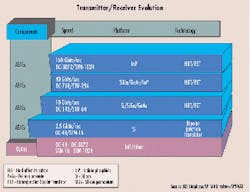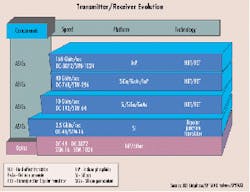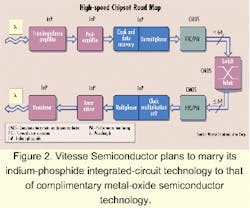OC-768 and beyond: More integration, new technologies shape future
Anita S. Becker, Integrated Communications Design
The market for terrestrial dense wavelength-division multiplexing (DWDM) optical components will grow at a compound annual rate of 50%, forecasts telecommunications market-research firm Ryan, Hankin, Kent (RHK-San Francisco), which anticipates the market will reach $8.6 billion in revenue by 2003. "The fastest growth in sources, modulators, and receivers for terrestrial DWDM applications is currently occurring at 10 Gbits/sec, with 40 Gbits/sec expected to surpass the 10-Gbit/sec market growth during the forecast period," says RHK's director of optical components, Jay Liebowitz.
A 40-Gbit/sec market? It seems like only yesterday that 10-Gbit/sec transmission rates popped up on the telecommunications radar screen.
Transmission-system development starts with cost-effective, reliable, and scalable integrated-circuit (IC) chipsets. Cur rent ly, the commercial viability of OC-768 networks is still in the hands of the semiconductor industry. "That is where the development cycle is at this point," says Lawrence Gasman, president of Communications Industry Researchers (CIR-Charlottesville, VA). "Chips are now being developed to try and make all this economical."
There is now a major economic incentive to develop the capabilities of high-speed chip technologies found in other industries because, for the first time, there are network-equipment manufacturers who want to buy these types of products. In the past, these materials were considered too costly and difficult to work with for the telecommunications applications of the time.Figure 1. As the data-transport rate in fiber increases, the fiber-optic transmitter/receiver electronics will migrate to higher-speed platforms where suitable application-specific integrated-circuit technologies will need to be developed in compound semiconductors with increased electronic carrier mobility. InP-based compound semiconductors possess the highest mobility, which are also well suited for telecommunication optical components.
Technologies for advanced high-speed circuits have been used in military and aerospace applications since the mid-1980s. "From the science and technology point of view, the achievable speed [40 Gbits/sec] has been around for quite some time but not in the commercial field of fiber-optics telecom," explains Dr. M. Nisa Khan, manager of the Advanced Technology Group, Epitaxx Div., JDS Uniphase (West Trenton, NJ). The company specializes in producing active components for fiber-optic networks. "Now that the fiber-optic field is taking off, scientists and engineers know that we can achieve speeds as high as OC-768, or 40 Gbits/sec, and that, in theory, it's possible to achieve 160 Gbits/sec [OC-3072]. Com mercialization, however, will take some time because it requires investments and resources."
Indium phosphide (InP) is likely to become instrumental in the making of ICs for optical as well as electrical components used in very-high-speed fiber-optic networks, says Khan. "Because its mobility is even higher than that of gallium arsenide (GaAs), InP is a natural material to make very-high-speed electronic IC components that are part of the fiber-optic transceivers," she explains.
Industry design efforts are focused on using GaAs ICs and InP optoelectronic devices for 40-Gbit/sec components, but a shift to a more monolithic InP approach is expected for greater speeds. Khan says packaging for radio-frequency and digital ICs also needs to be developed for speeds at 40 Gbits/sec and higher. "One of the things you will see is the merging of microwaves with optics as you go to higher and higher speeds, and this development is likely to be crucial for achieving electronic TDM at OC-768.
Some of the research and development at Epitaxx for developing technologies that can go to 40-Gbit/sec performance may also be suitable for 160-Gbit/sec devices. Using InP-based monolithic microwave ICs (MMICs), EPITAXX sees the potential for combining MMIC technology with optoelectronic technology (see Figure 1) for commercial products.
Vitesse Semiconductor Corp. (Cam arillo, CA) is also moving toward InP-based technology. The company uses a proprietary process technology it calls H-GaAs (high-integration gallium arsenide) to produce its high-speed chipsets.
It is now developing an advanced version of this technology for OC-768 using an InP heterojunction bipolar transistor (HBT) process for optoelectronic, analog, and physical-layer (PHY) functions, and complementary metal-oxide semiconductor ICs for process and framing and switch-fabric functions (see Figure 2)."At OC-768, we feel the MESFET [metal-epitaxial semiconductor field-effect transistor] technology is not applicable, and silicon germanium [SiGe] is very marginal at this speed, so we selected InP HBT, which is very fast," says Ira Deyhimy, vice president of advanced product development. "We are developing that and are calling it H-GaAs VI." He expects to start shipping samples this year. "We see 2002 as the year when it really starts ramping and getting deployed into the central core of the network."
PMC-Sierra (Burnaby, BC, Canada) recently introduced its Tiny Tera One (TT1) switching-fabric chipset for next-generation, high-speed, carrier-class equipment. The new chipset features what the company calls line-card-to-switch (LCS) protocol. Next-generation terabit-class switches and routers will require multirack system implementations to deal with the power and mechanical constraints of such large aggregate bandwidth, and the LCS architecture allows for physical separation between the switching fabric and the line-card racks.
Currently, the chipset can only scale to OC-192. "We are now in the process of defining OC-12 and OC-768 interfaces," says Anders Swahn, vice president and general manager of the company's Carrier Switching Div. "But the LCS protocol is speed-independent. We believe that when you are in the business of providing switching fabrics to the carrier space, we have to be approximately one generation ahead of where the sweet spot of wavelength-division multiplexing technology is so that when you build an architecture around this chipset and future chipsets, you have so-called future protection."
Early OC-768 networks are expected to be capable of transmitting data only across short spans of about 100 km to 400 km before needing signal regeneration. Analysts are predicting that initial deployments, starting as early as next year, will begin in metropolitan areas until long-haul transmission capability is commercially viable. Some in the industry believe that the regeneration and amplification issues associated with 40-Gbit/sec transmissions could be resolved as early as year's end.
"I think the most efficient form of amplification is going to be distributed Raman amplifier erbium-doped fiber amplifier [EDFA] combinations [for high-capacity networks]," says George Wildeman, product-line manager for amplifiers at Corning Inc. (Corning, NY). The Raman amplifier is the preamplifier and the EDFA is the booster amplifier. "If you don't have Raman amplification in 40-Gbit/sec systems-even if you're not trying to do long reach-you could only space these repeater huts about every 40 km, which would not be economical. If you want to keep the standard 80- to 100-km hut spacings, then the distributed Raman EDFA amplification allows you to achieve that span distance. It's providing reduced noise, but it's also extending the span length."
Corning is working with its customers in several areas, including EDFAs and distributed Raman amplifiers, for high-capacity systems. C-band and L-band amplifiers and polarization-mode-dispersion and chromatic-dispersion compensators for 40-Gbit/sec systems are under development, as are high-data-rate fiber-optic cables. Wildeman says the company's current dispersion compensators can be used at 40 Gbits/sec but are not optimized for that range. "When you get to 40 Gbits/sec, everything has got to be just right. That's where you need precise, tunable dispersion compensation," he says. "Right now, you can put a lot of passive boxes out in the field, but with a 40-Gbit/sec system, you're going to want to have wavelength-by-wavelength tuning. That's going to require some flexibility in the compensators."
Corning Lasertron (Bedford, MA), a recently acquired part of the Photonic Technologies Div., and Picometrix Inc. (Ann Arbor, MI), a developer of ultra-fast receiver products, jointly an nounced the availability of prototype samples of the QD-768 40-Gbit/sec photodetector at the Optical Fiber Communications Conference (OFC 2000) in Baltimore in March. Also introduced was Picometrix's Model P40A 40-Gbit/sec InGaAs PiN photo detector.
In the past six months, Lucent Technologies' Microelectronics Group (Breiningsville, PA), which designs and manufactures ICs and optoelectronic components, introduced two 40-Gbit/sec components, a lithium niobate (LiNbO3) modulator and a receiver. Both are still in development; however, samples are available for customers. The LiNbO3 modulator will be in production quantities by this summer. Samples of the receiver are due this month.
Future very-high-speed networks demand highly integrated functionality to resolve the inherent timing issues they bring. "As we look at the evolution of the 40-Gbit/sec LiNbO3 modulator, we see that we need to provide the electronics along with the discrete optical components," says Kim Trapp, senior marketing manager at Lucent's Opto electronics Div. "One of our key initiatives with the modulator and the 40-Gbit/sec receiver is to move to a highly integrated, fully automated [process]. What that means is, in the case of the LiNbO3 modulator, we'll be integrating with the modulator the required electronics, drivers, tunable lasers, all in a 'black box' for our customers. We want to move up the integration chain and provide additional functionality and added value to our customers by us worrying about some of the chipsets for them." Over the next 18 months, Lucent will put the 40-Gbit/sec receiver and modulator on an automated manufacturing platform similar to that used for its 10-Gbit/sec products.
It's not just the big-name component manufacturers that are developing OC-768 solutions. Many smaller companies such as startup optical-networking component manufacturer CyOptics (Los Angeles) are also working on supporting 40 Gbits/sec. CyOptics' InP-based products are small in size and enable integration of multiple functions such as signal generation, modulation, and power monitoring onto a single component. The company's electro-absorption modulator technology is targeted for implementation in 10-Gbit/sec and 40-Gbit/sec DWDM and optical time-domain multiplexing transmission systems.
By year's end, regeneration problems should be solved, but PHY issues will still be a problem, predicts Paramesh Gopi, marketing vice president at Entridia Corp. (Irvine, CA). "Assuming that the transmission comes through the optics, the next challenge is, how do you process the packet? I think it is very clear to at least the engineering community that we will not need to do microflow packet analysis."
OC-768 packet traffic will be handled through tag-based routing, most likely with Multiprotocol Label Switching tags in conjunction with Internet-protocol (IP) parameters.
To scale the backplane to OC-768c, or even OC-3072, routing and switching functions must be separated, with the routing piece native to each line card, Gopi says.
"We want to move as much intelligence as possible to the line-card level and leave the backplane as an ultra-fast highway to move the traffic between line cards," he explains. "The backplane then just directs packet traffic; it doesn't examine packet traffic. That means your backplane technology becomes independent of your line-card technology. So you can keep your backplane and just switch your line cards."
Entridia's customers are telling the company that initially an OC-768-type box is going to consist of channelized OC-48s. "Their take is that OC-768c, the concatenated version of OC-768, is probably going to start to be deployed sometime around the middle of next year," Gopi says. "But more importantly, by the end of this year, everybody wants to see a box that will do OC-768 worth of traffic. They want to be able to do 16 OC-48s in a small, single box-which accounts to OC-768 of traffic."
This spring, the company announced a new family of highly integrated, wire-speed packet engines for light-speed IP routers that are extensible up to OC-768. "We believe it's going to be packets everywhere, and IP over light is very important to our strategy," Gopi says. He expects to be able to demonstrate an OC-768c rate with Entridia's chipset by this fall. "By Q1 of next year, we'll be able to do essentially 16 OC-192c, and by the summer, we'll be able to do basically four OC-768c at line rate. That is our time frame to get silicon to do this stuff."
Another packet-engine supplier, Siber-Core Technologies (Kanata, ON, Canada) recently demonstrated its first packet-forwarding engine, the SiberCAM Ultra-2M, at the Gigabit Ethernet Conference in San Jose, CA, in March. SiberCore claims its packet-forwarding engine (PFE) can support up to OC-768 transmission for multigigabit and terabit routers and high-performance Ethernet switches. The company's new PFE is based on a new type of ternary content-addressable memory architecture; 16 Ultra-2Ms can be cascaded together to support over one million Ipv4 addresses in a single routing subsystem, with no search throughput performance penalty. The product is available now in production quantities.
At this point, no one can be expected to predict exactly what tomorrow's new technologies will be. Industry experts do agree speculatively that all-optical or hybrid-optical/microwave technologies are the most logical candidates to address the requirements of these very-high-speed, packet-based converged media networks of the future. Although high-capacity ICs and components are now showing up on radar screens throughout the industry, as yet they are merely blips.
Much of the technology to make these future networks cost-effective and reliable is currently in its infancy or not yet conceived.
Anita S. Becker is senior editor with Integrated Communications Design (ICD), Lightwave's sister publication. This article appeared in the May 2000 issue of ICD.


